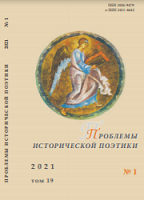Николай Чудотворец порукой: фольклорные и книжные версии сюжета
St. Nicholas the Miracle-Worker as Surety: Folklore and Book Versions of the Plot
Author(s): Vera S. KuznetsovaSubject(s): Christian Theology and Religion, Customs / Folklore, Studies of Literature
Published by: Петрозаводский государственный университет
Keywords: Slavic folklore; legends; folk hagiography; handwritten book writing; St. Nicholas the Miracle-Worker;
Summary/Abstract: The article presents the results of a study of hagiographic folk legends about St. Nicholas the Miracle-Worker as surety (AaTh 849*, SUS 849*), comparing them to the book versions of similar narratives. Categorized by the folklore prose indexes as the indicated plot type, these stories are not homogeneous in content, but include several forms of the plot that differ in their origin and nature of relations with the book. The narratives in the first two variants of the plot are relatively few in number. The first entails a merchant borrowing money, with a cross or an icon guarantor; money is thrown into the water in a barrel and floats to the lender by itself, and the second speaks about the icon of St. Nicholas the Miracle-Worker being entrusted with the protection of a house and property; and the icon being punished if the request addressed to it is not fulfilled. These plots demonstrate their dependence on book source, namely The Tale of Fyodor the Merchant and The Miracle of the Icon of St. Nicholas. The third variant of plot type 849* involves a poor man who uses an icon of St. Nicholas the Miracle-Worker as surety, borrows money, and cannot repay the debt. The lender punishes the guarantor icon, while the person who bought the icon attains happiness with the help of the saint. There are many both published and archival versions of this plot variant in the Eastern Slavic oral tradition, and it derives from a non-book origin. The folk narratives of this plot variety influenced the development of 17th century Russian manuscript writing, when figurative means, themes and plots were consciously transferred to literature from folklore. The oral hagiographic legend about St. Nicholas the Miracle-Worker was edited in accordance with the book tradition and transformed into the Tale of a certain wretched young man, contiguous with the non-book versions of the miracles of St. Nicholas the Miracle-Worker.
Journal: Проблемы исторической поэтики
- Issue Year: 19/2021
- Issue No: 1
- Page Range: 7-38
- Page Count: 32
- Language: Russian

